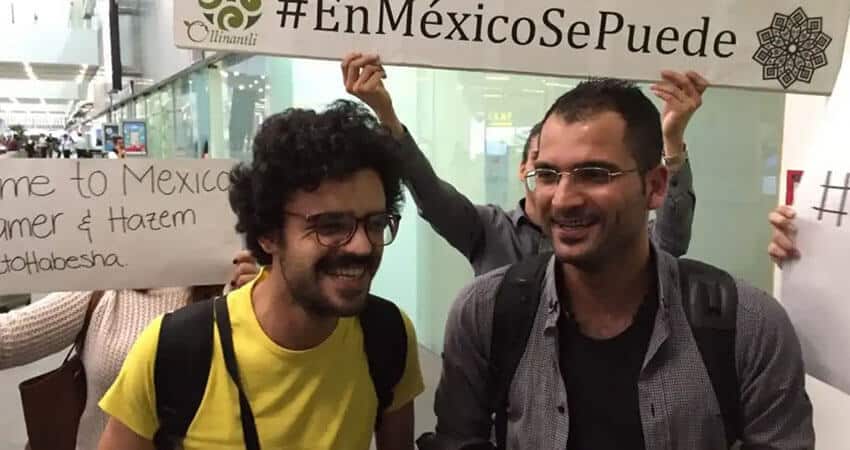Tacos al pastor, that most Mexican of foods, seen and served at the entrance to eateries from Merida to La Paz, Veracruz to Guanajuato, a food that has existed in the country since as far back as the first arrival of the sirio-libaneses (Syrian-Lebanese) community in the late 19th century.
Based on the shawarma spit-grilled meat found in Arab nations, tacos al pastor is now considered a quintessentially local dish. Likewise, kibis, wheat dough traditionally filled with ground meat — often sold on streets in the south by walking vendors — is derived from the Lebanese national dish, kibbeh, or kipe. Served with bitter oranges grown in the Yucatán Peninsula, and habanero chile, they are easily distinguishable for their potato-like shape and are popular with locals and tourists alike.
The amazing and unique Syrian-Lebanese heritage of Mexico, in fact, might completely pass you by if you did not know where to look for it.
“The Yucatán has always been a melting pot for people seeking a different way of life,” says Alejandro Azar Pérez, the Campeche Red Cross’ state delegate and the descendant of early 20th century Lebanese immigrants. “Even today,” he argues, “we see families arriving from all over the world to settle in the Yucatán, who are after the same change in lifestyle that my great-grandparents were searching for.”
The term sirio-libanes doesn’t mean Syrians with Lebanese heritage or vice-versa exactly, but it is the term Azar uses, as do other members of these two ethnic groups in Mexico. The reason for that has to do with the complicated history of where these Mexicans’ ancestors came from when they arrived here in the late 19th and 20th centuries to escape war, social turmoil and oppression.

The geographical region now spanning Syria and Lebanon has a long and richly textured history of being invaded, beginning with the Assyrians, Prussians, and Greeks, and continuing through the takeover by the Ottoman Empire in the 16th century. By the end of the nineteenth century, foreign domination and internal conflicts in the area were driving a huge exodus of Lebanese people out of their homeland in search of a better life. In the early 20th century, both Syria and Lebanon were one administrative entity under the Ottoman Empire, which then became independent states after World War I.
For many of these emigrants, the final destination was of little concern; their primary goal was finding better opportunities and a life away from poverty, exploitation and hunger.
Though most went in search of the American Dream, a sizable number traveled south to Uruguay, Argentina and Mexico in search of freedom. In 1878, the first Lebanese citizens to arrive in Mexico made land at the port of Tampico, in Veracruz.
In 1879, Santiago Sauma, the first Lebanese national to settle in the Yucatán arrived in Progreso. Most of the emigrants who traveled to Mexico began their journey alone, leaving wives, children and friends in Lebanon with the hope of forging ahead and establishing a secure living situation.
At the time, President Porfirio Díaz’s policies favored those looking to escape wretched situations in other countries. Hoping to increase Mexico’s economic prosperity and populate empty land, Díaz encouraged an active open-door immigration policy to attract individuals with skills and tenacity.
In 1905, one such ambitious individual — Alejandro Azar Azar — disembarked at the port of Progreso, Yucatán. Alongside his companion, Salima Farah Elias, he was hoping to try his luck at a better life on the peninsula, where he had heard there was an abundance of trade and commercial opportunities.

Even for those with little capital and no grasp of the Spanish language, it was said, life was more prosperous and much freer. The couple had few resources except for hope, good faith and a commitment to building a life for themselves.
Generations later, Azar Azar and Farah Elias’s family is spread across Mexico and has children, grandchildren and great-grandchildren almost too numerous to count.
Azar’s great-grandson, the aforementioned Alejandro Azar Pérez of Campeche’s Red Cross, recalls the tales he heard as a child, passed down by word of mouth, about his ancestry. As is often the case in the folk histories of diasporic cultures — groups who have moved outside of their place of origin to settle in other lands — the only ancestral history for many of the descendants of these immigrants is oral.
“Stories,” he says, “it was always stories. Stories told at every family event, and there were many. There still are many. Stories of how the first of our family came to be in Mexico. Where we came from. Who we are. What binds us together.”
Perhaps unsurprisingly given their shared past, the family has retained strong links despite the geographical distance. Like much of the Syrian-Lebanese community in Mexico, they helped construct a network that communicated between parts of the family across the country, as well as with their relatives across the ocean in Lebanon. It’s a network that is alive and well today and arguably still serves as modern Mexico’s most successful mercantile class, alongside the Galicians.
Because when you stop to look, or scratch beneath the surface, the Syrian-Lebanese community is everywhere and is now a de facto part of modern Mexico, inextricably so. It may be most felt publicly in quasi-Middle Eastern foods, but really there is no aspect of the country in the early 21st century that does not have the root and branch participation of this most unique and resilient of communities.
Shannon Collins is an environment correspondent at Ninth Wave Global, an environmental organization and think tank. She writes from Campeche.
